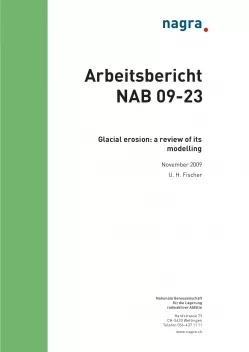
Arbeitsbericht NAB 09-23
Glacial erosion: a review of its modelling
Glaciers and ice sheets are important agents of erosion, transport and deposition and thus constitute an influential component in the evolution of the landscape which they cover. At the same time, glaciers and ice sheets respond dynamically to changes in boundary conditions, such as climatic variations and topographic adjustments. With the advent of numerical modelling techniques and recent advances in computer technology, modelling ice-sheet dynamics has become a powerful means to investigate the complex interactions between ice masses, the climate system and subglacial landforms in a quantitative way, in past as well as future environments.
Numerical models of ice flow have been applied to the existing ice sheets of Greenland and Antarctica, and those which covered the continents of the Northern Hemisphere during the Quaternary ice ages. Typical studies have concentrated on mechanisms and threshold of ice.sheet inception (e.g. Huybrechts 1994; DeConto & Pollard 2003a), ice-sheet form and extent during glacial–interglacial cycles (e.g. Marshall et al. 2000, 2002; Ritz et al. 2001; Charbit et al. 2002) and the response of the polar ice sheets to future climatic warming (e.g. Huybrechts & de Wolde 1999; Van de Wal et al. 2001). Related studies have considered ice sheets as sources of changes in surface loading for isostacy and gravity models (e.g. Le Meur & Huybrechts 2001; Tarasov & Peltier 2004) and changes in freshwater fluxes for ocean models (e.g. Schmittner et al. 2002; Fichefet et al. 2003). By accounting for interactions between thermal and flow regimes, ice-sheet models have also been used to investigate the potential for internally generated flow instability (e.g. Payne 1995; Payne & Dongelmans 1997; Marshall & Clarke 1997). In addition, models of the Greenland and Antarctic ice sheets are in use to assist with the dating and interpretation of ice cores (e.g. Greve 1997; Huybrechts et al. 2007).
In this review the emphasis is focused on the capability of glaciers and ice sheets to erode, transport and deposit substantial quantities of sediment. The discussion that follows concen.trates on models of ice flow that account for sediment erosion beneath glaciers and ice sheets. First, the main processes of glacial erosion and fundamental concepts of ice-sheet modelling are briefly introduced before various coupled ice-sheet/sediment models are presented and discussed.
